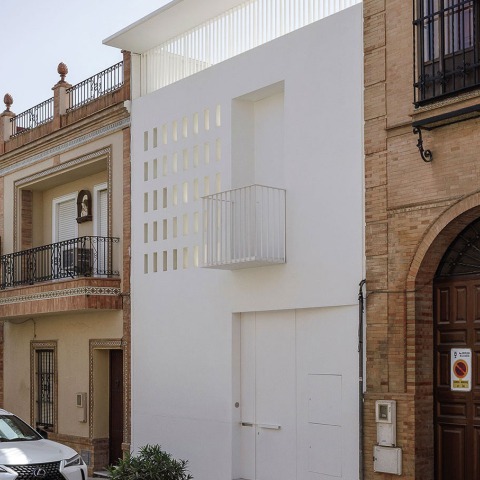The white color of the house designed by Sol89, which distinguishes it from the surrounding houses, recalls the old houses of Castilleja de la Cuesta, which have been lost in favor of others with the colors and materials of more commercial constructions. Other traditional elements of the village houses included in this one are a cornice-visor, a frieze, a balcony overlooking the street, the openwork wall, and the shutter on the door from which the courtyard-entrance hall can be glimpsed.

House of the nine frames by Sol89. Photograph by Fernando Alda.
Description of project by Sol89
Gemma and Álvaro decide to make their first home after decades of living in Belgium with the memory of their life in Catalonia and Asturias always present. They return to Andalusia, where he studied, looking for the life of a southern village, bright, peaceful, close to Seville, where they can meet up with a mutual friend.
They bought a plot of land measuring 5x30 meters with a single façade facing almost north on the main street. The plot is narrow and long, the result of the agricultural plots that allowed the coexistence of the house with some buildings for the storage of farm implements or corrals. The program to be developed is modest, with just a couple of bedrooms and a few special features, such as a room where they can both enjoy a sauna, a place where Gemma can make engravings, and where they can have a small outdoor kitchen. They expect visits from friends and family from time to time whom they would like to welcome. They carry objects, books, and paintings, traces of a lifetime, they also carry with them memories of having lived in intense places whose experience they would like to recover: a well and a tree, a courtyard, the southern light.
The proportions of the site and the agricultural memory of these plots suggest generating space by repeating equidistant frames, which define bays that are built on one or two floors or are hollowed out to generate courtyards, providing a continuous space that gradually shades its environmental and functional characteristics. In this way a sequence is created, with a first reception courtyard that qualifies the relations with the street, then three centrelines that house the dwelling, one more centrelines of which only the structure remains to formalize a shaded porch in the manner of a canopy, two bays that constitute the courtyard to the south (more like a "hortus conclusus") and the last volume that finishes off the site as a pavilion where to paint and cook with friends, whose roof, lower than the rest of the house, is planted with shrubs, a continuation of the garden where the well and the tree that lived in Gemma's memory take shape as a persimmon tree and a small pool whose emptying provides the water for irrigation.
The metallic construction of this structure and the almagra color, typical of the first paints that once protected the steel, rhythms the space and form a continuous reference. The standard portico recesses the supports concerning the party walls to avoid conflicts with the neighboring houses with load-bearing walls, and the resulting space between this structural line and the longitudinal boundaries is occupied with the equipment, technical spaces, and storage of the home, creating two unequal lateral bands that redefine the limits of the dwelling. By opening up the house at the ends to two courtyards to the north and south, a series of ventilators installed in each bay, and a natural ventilation chimney situated on the side of the middle bay, a cross breeze is provided in all the rooms which, together with the protection of the south elevation with the canopy that will soon be covered with bignonias, alleviates the southern heat.
The house appears on the street as a massive, white construction, an imitation of the first constructions of Castilleja that have been gradually lost, replaced by colors and materials typical of the more commercial and immediate construction industry. A cornice-visible window, a frieze, a balcony overlooking the street, the openwork wall, and the shutter of the door from which to glimpse the courtyard-entranceway establish a syntax that refers to elements of popular architecture that facilitate the encounter between the private and the public and help to build the street.














































